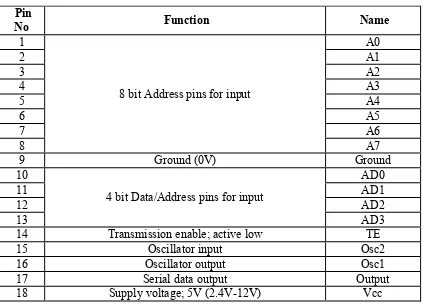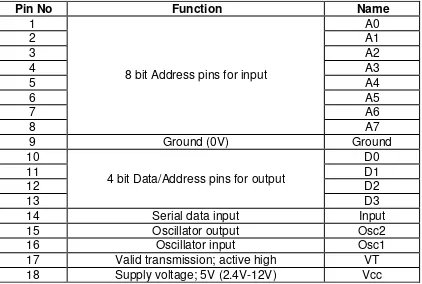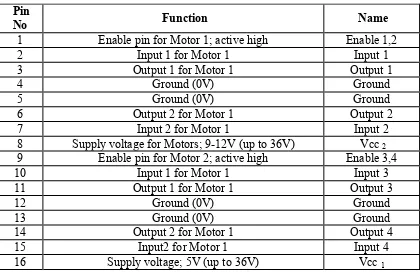UNIVERSITI TEKNIKAL MALAYSIA MELAKA
Remoted Operated Car Robot by Using Mobile Phone (Arduino)
This report submitted in accordance with requirement of the Universiti Teknikal Malaysia Melaka (UTeM) for the Bachelor Degree of Electronic Engineering
Technology
(Telecommunication) with Honours
by
MUHAMMAD NAJMUDDIN BIN NAZLI B071210077
910520-10-5045
UNIVERSITI TEKNIKAL MALAYSIA MELAKA
BORANG PENGESAHAN STATUS LAPORAN PROJEK SARJANA MUDA
TAJUK: Remoted Operated Car Robot by Using Mobile Phone (Arduino)
SESI PENGAJIAN: 2014/15 ( Semester 1 )
Saya MUHAMMAD NAJMUDDIN BIN NAZLI
mengaku membenarkan Laporan PSM ini disimpan di Perpustakaan Universiti Teknikal Malaysia Melaka (UTeM) dengan syarat-syarat kegunaan seperti berikut:
1. Laporan PSM adalah hak milik Universiti Teknikal Malaysia Melaka dan penulis. 2. Perpustakaan Universiti Teknikal Malaysia Melaka dibenarkan membuat salinan
untuk tujuan pengajian sahaja dengan izin penulis.
3. Perpustakaan dibenarkan membuat salinan laporan PSM ini sebagai bahan pertukaran antara institusi pengajian tinggi.
4. **Sila tandakan ( )
SULIT
TERHAD
TIDAK TERHAD
(Mengandungi maklumat yang berdarjah keselamatan atau kepentingan Malaysia sebagaimana yang termaktub dalam AKTA RAHSIA RASMI 1972)
(Mengandungi maklumat TERHAD yang telah ditentukan oleh organisasi/badan di mana penyelidikan dijalankan)
(TANDATANGAN PENULIS)
Alamat Tetap:
3-03 QRTS ILSAS, KM7 JLN KAJANG / PUCHONG, BEG BERKUNCI 205, 43650 BDR BRU BANGI, SELANGOR
Tarikh: ________________________
Disahkan oleh:
(TANDATANGAN PENYELIA)
Cop Rasmi:
i
DECLARATION
I hereby, declared this report entitled “Remoted Operated Car Robot by Using Mobile Phone (Arduino)” is the results of my own research except as cited in
references.
Signature : ……….
Name : MUHAMMAD NAJMUDDIN BIN NAZLI
APPROVAL
This report is submitted to the Faculty of Engineering Technology of UTeM as a partial fulfillment of the requirements for the degree of Bachelor of Electronic Engineering Technology (Telecommunication) with Honors. The member of the supervisory is as follow:
……….
iii
DEDICATION
Alhamdullillah, praise to the Almighty ALLAH S.W.T.
This thesis is dedicated to
My beloved family, My Friends, and my lecturer
ACKNOWLEDGEMENT
I would like to thank my Lord Allah the most gracious and merciful who gives me the ability to finish this project. Firstly, I wish to express sincere appreciation to Universiti Teknikal Malaysia Melaka (UTeM) for giving me a chance to further my study on Bachelor’s Degree in Electronic Engineering Technology (Telecommunications) in Faculty of Engineering Technology (FTK).
I would like to express my heartily and sincerity thankfulness to my project supervisor, Madam. Ika Dewi binti Saiful Bahri for the guidance, advices, encouragement and attention given throughout the development of my final year project and while writing this report Remoted Operated Car Robot by Using Mobile Phone (Arduino)
.
Without his continued support and interest, the project would not be like what it likes today.My gratitude goes to my beloved family and all my friends that always gives courage and supports me to achieve the goal of my project. Thank for their moral support and great care that they had given to me. Even though they are not always with me, but the family bond keeps us together every moment.
v
ABSTRACT
ABSTRAK
Kebanyakkan pengawalan robot tanpa wayar adalah menggunakan modul RF. Akan tetapi, dengan projek ini, akan memanfaatkan telefon mudah alih Android anda untuk mengawal robot untuk bergerak. Segala arahan yang dikeluarkan sudah tersedia berbanding modul yang terdapat pada RF. Untuk pengguna telefon mudah alih Android hendaklah memuat turun aplikasi ke dalam telefon bimbit anda dengan menggunakan MIT apps dan juga haruslah memuat turun kod data perisian Arduino
modul dan sambungkan pada telefon bimbit tersebut. Kemudian, pengguna
vii
1.4 Report Organizations ... 4
CHAPTER 2 ... 5 2.1.1 Using the Android Platform to Control Robots ... 6
2.1.2 Remote Control Robot Using Android Mobile Device ... 6
2.2 Hardware ... 7
2.2.1 Wireless CCD Camera ... 7
2.2.2 HT 12D and HT 12E ... 7
2.2.3 L293D Motor Driver ... 11
2.2.4 Resistor ... 12
2.2.5 Arduino ... 13
2.2.7 DC Motor ... 18
2.3 Software ... 19
2.3.1 Arduino software IDE ... 19
2.3.2 Apps Inventor ... 20
2.3.3 Proteus 7 ... 21
2.3.4 Android ... 22
CHAPTER 3 ... 24
METHODOLOGY ... 24
3.0 Project Development Process ... 24
3.1 The Architecture of System ... 27
3.2 Design Components ... 28
3.2.1 Arduino Module ... 28
3.3 The main hardware selection ... 28
3.3.1 Motor Driver (L293D) ... 30
CHAPTER 4 ... 32
RESULT AND DISCUSSION ... 32
4.0 Software development Result ... 32
4.0.1 Interface between Arduino and Android ... 32
4.0.2 Interface between HC-05 Bluetooth module and Arduino ... 36
4.1 Hardware Development Result ... 38
4.2 Discussion ... 40
CHAPTER 5 ... 42
CONCLUSION AND RECOMMENDATION ... 42
5.0 Conclusion ... 42
5.1 Recommendations ... 43
REFERENCES ... 44
APPENDIX A ... 45
(Arduino Source Code) ... 45
APPENDIX B ... 48
(L293D Data Sheet) ... 48
APPENDIX C ... 51
ix
LIST OF FIGURE
Figure 1.1: The example of the prototype ... 2
Figure 2.1: Wireless CCD Camera... 7
Figure 2.2: Microcontroller HT12E ... 8
Figure 2.3: Microcontroller HT12D ... 10
Figure 2.4: Microcontroller L293D... 11
Figure 2.5: Colour code of resistor ... 13
Figure 2.6: Arduino Uno ... 13
Figure 2.7: Arduino Uno pin description ... 14
Figure 2.8 : Bluetooth Connectivity ... 16
Figure 2.9 : Layers in a Bluetooth ... 17
Figure 2.10 : HC-05 Bluetooth Module ... 18
Figure 2.11 : R260 DC Motor ... 19
Figure 2.12 : Arduino Software IDE ... 20
Figure 2.13: Flow of Apps Inventor ... 21
Figure 2.14 : Proteus 7 Software ... 21
Figure 2.15 : Android and Google logo ... 23
Figure 3.1 : Flowchart of the project ... 25
Figure 3.2 : An overview of architecture of the project ... 27
Figure 3.3 : L293D DC motor driver circuit ... 31
Figure 4.1 : Connection between Arduino and Bluetooth Module ... 36
Figure 4.2 : Connection between L293D motor driver circuit and Arduino Module 38 Figure 4.3 : PCB layout on Eagle Software ... 39
LIST OF TABLE
Table 2.1: Pin description for HT12E ... 9
Table 2.2: Pin description of HT12D ... 10
Table 2.3: Pin description of L293D ... 12
Table 2.4 : Summary of pin ... 15
Table 2.5 : The three Bluetooth Power Class ... 16
Table 3.1: Summary of the project development process ... 26
Table 3.2 : Main hardware selection ... 28
Table 3.3 : Comparison between L293D and L298N motor drivers... 30
Table 4.1 : Procedure for compiling and upload the program ... 33
1
CHAPTER 1
INTRODUCTION
In today’s technology that currently running with time, it actually occupied human lifestyle. Although, there is an interest thing about the technology in our routine lives even someone whose lifestyle is very far away for a well-known about technology nowadays. So that, this is one of our responsibility to design a new or upgrade a reliable systems which can be efficiently used by them whether for our daily life or safety in industry. This basic idea gave birth to the project Remote Operated Spy Robot Using Android Mobile Phone (Arduino Module) to control the moving of the robot.
1.0 Background Project
for user to use it and it will not be a weird thing that they have to do. In the previous project, they use a special remote control which has four switches to control the robot in four directions. But in this project, it will upgrade new things which use a mobile phone as a remote to control all of them. The example of the prototype for this project is shown in Figure 1.1 below.
Figure 1.1: The example of the prototype
The robot senses the surroundings through the CCD camera and sends to the receiver through the Radio Frequency wireless communication (mobile phone). The wireless CCD camera can be observed the surroundings in the computer or the phone itself. Android is a software stack for mobile devices that includes an operating system, middleware and key applications. Android boasts a healthy array of connectivity options, including Wi-Fi, Bluetooth and wireless data over a cellular connection. The controlling device of the whole system is a Microcontroller. Bluetooth module, DC motors are interfaced to the Microcontroller. The data received by the Bluetooth module from Android smart phone is fed as input to the controller. The controller acts accordingly on the DC motors of the robot. The robot in the project can be made to move in all the four directions using the Android phone.
1.1 Problem Statement
3
upgrade follow the technology era nowadays. The limitation is this system does not work for longer distance which the maximum controllable range is 125 meters. So that, the robot have exceed the limit to do the dangerous thing such as observed the behaviour of wild animals where human beings cannot reach. Besides that, this system also can use in army applications to detect the bombs. With this robot, it can avoid human lives threatened. In military, when the situation out of control, we can use this robot to identify the enemy and also the possibilities in the bomb site from the soldier not die in vain. After that, this system also can use in industries. For example, in the chemical industry, there are so many type of chemical can cause the workers to be in danger in life or can get health problem.
1.2 Project Objectives
In this project, discuss about the Remote Operated Spy Robot using Mobile Phone and the main objectives of this project are ;
1) To understand and develop the Remote Operated Spy Robot using Mobile
Arduino module for the controller and do an installation until it can use as the objective of this project.
1.4 Report Organizations
In this part will explain all the process and the flow for completing this report and project. This report will be conducted in few chapters and each stated as below:
Chapter 1: Introduction
This chapter will simply introduce about the project. This chapter contains background of project, objectives, problem statements, work scope and report organizations.
Chapter 2: Literature Reviews
This chapter explain about research of related or previous project. The literature about the previous project is stated in this report. The summarisation about the previous project will be included.
Chapter 3: Methodology
This chapter shows about the project methodology. The methodology based on System Development Life Cycle (SDLC) to evaluate this project. The simulation and analyse about this project will be discuss in this circuit.
Chapter 4: Expectation Results
In this chapter, it will state out the expectation result that will be obtained when some simulation is done by using the software.
Chapter 5: Conclusion
5
CHAPTER 2
LITERATURE REVIEW
2.0 Introduction
This chapter will discuss on previous projects and some journals that related to this project. This journal and reports have been analysed carefully to improve the effectiveness and quality of this project. By analysing the previous, the possibilities that affect the quality in their projects can be analysed and reviewed. From the previous project, idea can be implemented and to improve the project. Therefore, literatures review process start from beginning of project until the end of the project. Besides analysing the previous project, reviews from internet and books which are very effective to this project is done. Throughout the analysis at the beginning of the project, the special feature in this project is determined and the components used in this project are decided. Lastly the concept of the system of this project is well understood.
2.1 Previous Project
2.1.0 Design and Implementation of Remote Operated Spy Robot Control System
remote controller by using PIC 16F628A and PIC 16F877. The spy robot is made up of the wireless camera, an antenna, batteries and four movable wheels. CCD camera is used to capture information surrounding the robot. A 4 bits LCD display is mounted on remote controller to view user command. To use the spy robot in the dark area as night, the CCD is set up with LED that connected by lighting circuit. Radio Frequency modules signals are used in wireless remote control system for transmitting and receiving wireless logic signals to control the motors of the Spy robot control system. The three Brush DC motors and the two L298N are used to drive the Brush DC motors respectively.
2.1.1 Using the Android Platform to Control Robots
Based on the (Göbel & Jubeh, 2011), the Android Mobile Phone Platform by Google becomes more and more popular among software developers because of its powerful capabilities and open architecture. As it’s based on the java programming language, its ideal lecture content of specialized computer science courses or applicable to student projects. They think the project is a great platform for a robotic system control, as it provides plenty of resources and already integrates a lot of sensors. The java language makes the system very attractive to apply state of the art software engineering techniques, which is their main research topic. The unsolved issue is to make the android device interoperate with the remaining parts of the robot: actuators, specialized sensors and maybe co-processors. So that, they have discussed the various connection methods and present a first approach to connect Android with the LEGO Mind storms NXT robotics system, which they successfully used in their robotics / software engineering courses so far.
2.1.2 Remote Control Robot Using Android Mobile Device
7
technology. The application allows the robot control interaction with the display or voice. When they use a graphical interface, they can monitor the current distance of the robot from obstacles. The measurement of distance is carried out by ultrasonic sensor placed in front of the robot. It was necessary to build a prototype of a mobile robot for the development of the application. The prototype of the mobile robot is based on the differential gear.
2.2 Hardware
2.2.1 Wireless CCD Camera
The operating voltage of CCD camera is 12V DC. The supply for this camera is taken from the motors battery. The output signals of this camera are in the form of audio and video. These types of cameras are commonly available in the market (Electronicshub, 2015). The Figure 2.1 shows the example of wireless CCD Camera.
Figure 2.1: Wireless CCD Camera
2.2.2 HT 12D and HT 12E
Simply put, HT12E converts the parallel inputs into serial output. It encodes the 12 bit parallel data into serial for transmission through an RF transmitter. These 12 bits are divided into 8 address bits and 4 data bits.
HT12E has a transmission enable pin which is active low. When a trigger signal is received on TE pin, the programmed addresses/data are transmitted together with the header bits via an RF or an infrared transmission medium. HT12E begins a 4-word transmission cycle upon receipt of a transmission enable. This cycle is repeated as long as TE is kept low. As soon as TE returns to high, the encoder output completes its final cycle and then stops (EngineerGarage, 2012). The Figure 2.2 shows the example of Microcontroller HT12E and Table 2.1 shows the pin description for HT12E.
9
Table 2.1: Pin description for HT12E
Pin
No Function Name
1
8 bit Address pins for input
A0
4 bit Data/Address pins for input
AD0
11 AD1
12 AD2
13 AD3
14 Transmission enable; active low TE
15 Oscillator input Osc2
16 Oscillator output Osc1
17 Serial data output Output
18 Supply voltage; 5V (2.4V-12V) Vcc
HT12D is a decoder integrated circuit that belongs to 212 series of decoders. This series of decoders are mainly used for remote control system applications, like burglar alarm, car door controller, security system etc. It is mainly provided to interface RF and infrared circuits. They are paired with 212 series of encoders. The chosen pair of encoder/decoder should have same number of addresses and data format. transmission in indicated by a high signal at VT pin.
is received (EngineersGarage, 2012). The Figure 2.3 shows the example of Microcontroller HT12D and Table 2.2 shows the pin description of HT12D.
Figure 2.3: Microcontroller HT12D
Table 2.2: Pin description of HT12D
Pin No Function Name
1
8 bit Address pins for input
A0
4 bit Data/Address pins for output
D0
11 D1
12 D2
13 D3
14 Serial data input Input
15 Oscillator output Osc2
16 Oscillator input Osc1
11
2.2.3 L293D Motor Driver
L293D is a dual H-bridge motor driver integrated circuit (IC). Motor drivers act as current amplifiers since they take a low-current control signal and provide a higher-current signal. This higher current signal is used to drive the motors.
L293D contains two inbuilt H-bridge driver circuits. In its common mode of operation, two DC motors can be driven simultaneously, both in forward and reverse direction. The motor operations of two motors can be controlled by input logic at pins 2 & 7 and 10 & 15. Input logic 00 or 11 will stop the corresponding motor. Logic 01 and 10 will rotate it in clockwise and anticlockwise directions, respectively.
Enable pins 1 and 9 (corresponding to the two motors) must be high for motors to start operating. When an enable input is high, the associated driver gets enabled. As a result, the outputs become active and work in phase with their inputs. Similarly, when the enable input is low, that driver is disabled, and their outputs are off and in the high-impedance state. The Figure 2.4 shows the example of Microcontroller L293D and Table 2.3 shows the pin description of L293D.
Table 2.3: Pin description of L293D


